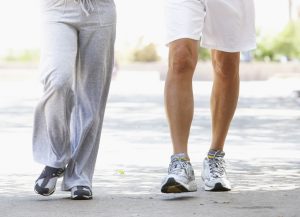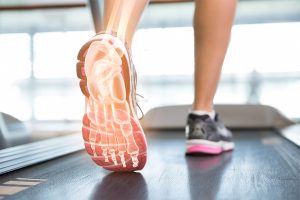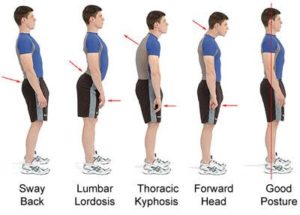When was the last time you thought about the way you walked?
 Chances are that you’ve been doing it on autopilot for so long that your habits, patterns and techniques are deeply ingrained. Unfortunately, this doesn’t factor in the changes that our bodies, specifically our feet, undergo over the years. From thinning fat pads (that cushion our steps) to fragile or stiff bones, our walking technique (“gait pattern”) can either help keep us going comfortably for many years to come – or leave us in pain and needing help.
Chances are that you’ve been doing it on autopilot for so long that your habits, patterns and techniques are deeply ingrained. Unfortunately, this doesn’t factor in the changes that our bodies, specifically our feet, undergo over the years. From thinning fat pads (that cushion our steps) to fragile or stiff bones, our walking technique (“gait pattern”) can either help keep us going comfortably for many years to come – or leave us in pain and needing help.
Today, we’re sharing four small changes you can make to your gait today to help you move more efficiently, use less energy (so you get less tired) and help reduce your risk of injury. Please tell your future self – you’re very welcome.
The first step – feel the way you walk
Your first task is to get a better idea of how you are walking now. Ditch any mobile devices, take out the headphones, go for a walk and start to register what is happening.
- Does your heel hit the ground before your toes?
- Do your calves feel tight?
- Are you lifting your hip while you walk?
You feel your hip lifting a little when you walk
Hip ‘hitching’ can be the result of a small leg length difference (often undetected), with the longer leg needing a little more height so that it doesn’t hit the ground as it swings through. Another reason for lifting the pelvis is a learnt behaviour in which we get used to ‘swaying’ as we walk.
As one side of the hip shifts upwards, the lower back compresses with every step, and more weight stays on the other hip (and therefore leg, knee and foot) for longer as you walk.
The solution is to keep your pelvis level by correcting any problems that are causing it to rise. If it’s because of a leg length difference, we can help by building up the height of an orthotic to brings your hips back into alignment.
Your strides are too long
 When you push off the ground to take a step, there is power behind your stride to keep you propelling forward efficiently. By the time your foot comes in contact with the ground, you get another ‘power boost’ from the back foot to drive your next step forward, and so you keep going, step after step.
When you push off the ground to take a step, there is power behind your stride to keep you propelling forward efficiently. By the time your foot comes in contact with the ground, you get another ‘power boost’ from the back foot to drive your next step forward, and so you keep going, step after step.
When your strides are too long, you step too far out in front, causing you to lose a lot of that power and put more stress on your muscles and joints. Due to the repetitive nature of walking, your legs can feel more tired and achy at the end of the day.
The solution is to familiarise yourself and get comfortable with what the right stride length is for you, which will vary from person to person. Stay mindful, and begin to recognise when you’re overstriding and the effects it’s having on your feet and legs. If you need to walk faster, take smaller, quicker steps instead of increasing your stride.
Lifting your heel off the ground too early
It is only when the opposite foot has come securely in contact with the ground that the back foot should be lifting up and swinging through to land a step in front of the other. Instead, many people start to lift the heel of the back foot while the front foot is still swinging through, before it has made contact with the ground.
The result is that the front of the foot is loaded with more pressure on every step, as the weight is carried by the forefoot only and not over the heel too. Over time and many thousands of steps each day for months, this can result in pain at the forefoot, or even contribute to the development of a bunion if the force travels along the inside border of the foot before the toes leave the ground.
This pattern is often caused by tight calf muscles that ‘pull’ on the back of the heel as the Achilles tendon and calves don’t have the flexibility to keep the heel planted on the ground. This means that the solution starts by assessing your calf tightness and working to address this first.
Stop looking down at your mobile device

If you think this one isn’t directly related to your lower limbs, you’re very wrong. Aside from the poor neck and spinal posture, walking while constantly focused on your mobile device doesn’t leave much concentration room for you to think about your gait or make conscious movements. You may knock your knees, not maintain a healthy stride length, hit the ground with your foot while it’s swinging through (which means tripping!) and develop a range of unhealthy habits. Keep your head facing straight ahead, walk with level shoulders and swing your arms to help maintain a healthy and efficient gait.
Changing your gait by yourself can be hard…
… And recognising your own poor gait patterns can be even harder. Many people don’t realise the relationship between the way they move and their aches and pains – not just in the lower limbs, but throughout the entire body, including the back and neck.
This is why analysing your gait is not only something we do as a standalone service, but for everyone that comes in with foot, leg or knee pain. By watching you walk, we can often pinpoint causes of your problem and create the right treatment plan for you.
We also video record your gait to show you exactly what you’re doing and the impact that it’s having, so you know and understand what you should be looking out for and why.
To book an appointment to see how we can help your gait, book online by clicking the button at the top of the screen or call us on 1800 366 837


